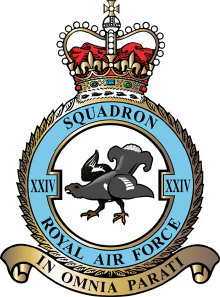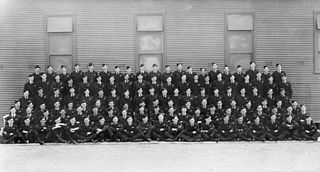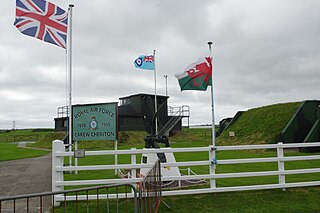
No. 24 Squadron (also known as No. XXIV Squadron) of the Royal Air Force is the Air Mobility Operational Conversion Unit (AM OCU). Based at RAF Brize Norton in Oxfordshire, 24 Squadron is responsible for aircrew training on A400M Atlas and C17 Globemaster. The squadron also delivers or oversees engineer training for these aircraft.
Royal Air Force Bircham Newton or more simply RAF Bircham Newton is a former Royal Air Force station located 2.1 miles (3.4 km) south east of Docking, Norfolk and 13.4 miles (21.6 km) north east of King's Lynn, Norfolk, England.

No. 1 Operational Training Unit (No. 1 OTU) was an operational conversion unit of the Royal Australian Air Force (RAAF) during World War II. Formed in December 1941 at Nhill, Victoria, it relocated to Bairnsdale in mid-1942, and then to East Sale the following year. No. 1 OTU's primary role was to train aircrew for multi-engined aircraft operations. At its peak of activity in August 1944, it was operating over 130 aircraft, the most numerous being Bristol Beauforts. Its aircraft and personnel also conducted transport missions in New Guinea and maritime patrols in southern Australian waters. Following the end of hostilities, the unit was disbanded in December 1945.
Royal Air Force Thornaby, or more simply RAF Thornaby, is a former Royal Air Force Station located in the town of Thornaby-on-Tees, in the North Riding of Yorkshire, England. Fighter Command, Bomber Command and Coastal Command all operated from the base over its history, but its stint under Coastal Command is what the base was notable for, particularly in the air-sea rescue environment and the development of the Thornaby Bag. This was an emergency bag dropped to downed aircrew at sea and contained food, cigarettes and drink.
No. 236 Operational Conversion Unit was a Royal Air Force Operational Conversion Unit which was active between 1947 and 1992 and formed by re-numbering and merging different units.
Number 76 Squadron was a squadron of the Royal Air Force. It was formed during World War I as a home defence fighter squadron and in its second incarnation during World War II flew as a bomber squadron, first as an operational training unit and later as an active bomber squadron. With the end of the war the squadron converted to the role of transport squadron, to be reactivated shortly in the bomber role during the 1950s. From 2007 to 2011, it was a training unit, equipped with the Short Tucano at RAF Linton-on-Ouse.

Royal Air Force Haverfordwest or more commonly RAF Haverfordwest, is a former Royal Air Force station located 2.1 miles (3.4 km) north of Haverfordwest, Pembrokeshire and 11 miles (18 km) south of Fishguard, Pembrokeshire, Wales.

Royal Air Force Talbenny, or more simply RAF Talbenny, is a former Royal Air Force station located 5.6 miles (9.0 km) north west of Milford Haven, Pembrokeshire and 7.9 miles (12.7 km) south west of Haverfordwest, Pembrokeshire, Wales.

Royal Air Force Carew Cheriton, or more simply RAF Carew Cheriton, is a former Royal Air Force station located near Carew, Pembrokeshire. It was situated 4.7 miles (7.6 km) north west of Tenby.
Royal Air Force Honeybourne, or more simply RAF Honeybourne, was a Royal Air Force station located 0.6 miles (0.97 km) south of Honeybourne, Worcestershire, England and 4.6 miles (7.4 km) east of Evesham, Worcestershire, England
Royal Air Force Silloth, or more simply RAF Silloth, is a former Royal Air Force station one mile (1.6 km) north-east of Silloth, Cumbria, England, and 6.7 miles (10.8 km) south-west of Kirkbride, Cumbria. The station was used by RAF Coastal Command.

No. 2 (Coastal) Operational Training Unit RAF, was a training unit of the Royal Air Force, within No. 17 Group RAF, which was part of RAF Coastal Command. The unit started operating from late 1940 and disbanded during early 1944.

No. 3 (Coastal) Operational Training Unit RAF, was a training unit of the Royal Air Force, within No. 17 Group RAF, which was part of RAF Coastal Command. The unit started operating from late 1940 and disbanded at the start of 1944, being absorbed into No. 6 OTU.

No. 16 Group RAF was a group of the Royal Air Force. It existed over two periods in two different roles. No. 16 Group was initially a training group, from 1918 to 1920, that had been transferred from the Royal Flying Corps. It reformed as a reconnaissance group under RAF Coastal Command, in 1936.

No. 17 Group RAF was a group of the Royal Air Force which was operational in the last year of the First World War, and throughout the Second World War.

Coastal Command Anti U-Boat Devices School RAF was a training unit of the Royal Air Force and part of RAF Coastal Command. The unit was established during April 1945 by the redesignating of an existing RAF Coastal Command unit. The unit had several different identities beforehand. It began as the short lived No. 7 Operational Training Unit which only existed during 1940, before reforming in 1942 as No. 7 (Coastal) Operational Training Unit. It disbanded and was redesignated a few more times before becoming the Coastal Command Anti U-Boat Devices School.

Air-Sea Warfare Development Unit RAF (ASWDU) was a research and development unit of the Royal Air Force, within RAF Coastal Command, it was operational from December 1940 and disbanded in April 1970.

No. 5 (Coastal) Operational Training Unit RAF, was a training unit of the Royal Air Force, within No. 17 Group RAF, which was part of RAF Coastal Command. The unit was established during August 1941 and disbanded during August 1945.









